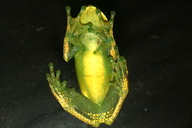|
Aplastodiscus albosignatus (Lutz & Lutz, 1938)
Bocaina Tree Frog, perereca-verde | family: Hylidae subfamily: Hylinae genus: Aplastodiscus |
|
Taxonomic Notes: Berneck, Haddad,Lyra, Cruz and Faivovich [2016 Mol Phylog Evolution 97:213-223] show that topotypic specimens of Aplastodiscus albosignatus and Aplastodiscus callipygius are almost identical in studied DNA sequences and the taxa are inter-nested in phylogenetic analysis. The taxa are also morphologically similar. Accordingly, A. callipygius is treated as a junior synonym of A. albosignathus. AmphibiaWeb has a species account for A. albosignatus written in English and another for A. callypigius written in Portuguese. We have photographs attributed to both putative taxa. Everything is now presented as A. albosignatus, but readers should be aware of the need to revise the species accounts. AmphibiaWeb welcomes such a revision, in either English and Portuguese, or preferably both. |
|
 © 2009 Diogo B. Provete (1 of 25) |
|
|
|
Description The tadpole was described by Gomes (1996): body oval in dorsal view, nares reniform, spiracle sinistral, vent tube dextral, caudal muscle well-developed, oral apparatus ventral, LTRF 2(2)/4(1), a single layer of marginal papillae, submarginal papillae present. The general dorsal color is green, as well as the muscles and bones. Distribution and Habitat Country distribution from AmphibiaWeb's database: Brazil
Life History, Abundance, Activity, and Special Behaviors The tadpoles are benthic and can be found in narrow streams, with clay bottoms. Newly metamorphosed froglets are 21 mm in SVL and have some black spots on the dorsum (Gomes 1996). Defense strategies include body lifting, distress calls and camouflage (Haddad et al. 2008). Trends and Threats Possible reasons for amphibian decline General habitat alteration and loss Comments
References
Abrunhosa, P.A., Pimenta, B.V.S., Cruz, C.A.G., and Haddad, C.F.B. (2005). ''Advertisement calls of species of the Hyla albosignata group (Amphibia, Anura, Hylidae).'' Arquivos do Museu Nacional, 63, 275-282. Carvalho-e-Silva, S. P. and Cruz, C. A. G. (2004). Aplastodiscus callipygius. In: IUCN 2009. IUCN Red List of Threatened Species. Version 2009.1. www.iucnredlist.org. Downloaded on 14 September 2009. Cruz, C. A. G. and Peixoto, O. L. (1984). ''Espécies verdes de Hyla do complexo ''albosignata'' (Amphibia, Anura, Hylidae).'' Arquivos da Universidade Federal Rural do Rio de Janeiro, 7, 31-47. Gomes, M. R. (1996). Girinos de espécies de Hyla do grupo ''albosignata'' (Amphibia, Anura, Hylidae). Master's thesis, Departamento de Zoologia, UFRJ-MN. Gomes, M. R. and Peixoto, O. L. (1997). ''Hyla callipygia – Distribution extension.'' Herpetological Review, 28, 92-93. Haddad, C. F. B., Toledo, L. F., and Prado, C. A. (2008). Anfíbios da Mata Atlântica – Atlantic forest amphibians. Editora Neotropica, São Paulo. Haddad, C. F. B., and Prado, C. P. A. (2005). ''Reproductive modes in frogs and their unexpected diversity in the Atlantic Forest of Brazil.'' BioScience, 55, 207-217. Originally submitted by: Diogo B. Provete (first posted 2017-01-13) Edited by: Ann T. Chang (2020-07-07) Species Account Citation: AmphibiaWeb 2020 Aplastodiscus albosignatus: Bocaina Tree Frog <https://amphibiaweb.org/species/704> University of California, Berkeley, CA, USA. Accessed May 28, 2025.
Feedback or comments about this page.
Citation: AmphibiaWeb. 2025. <https://amphibiaweb.org> University of California, Berkeley, CA, USA. Accessed 28 May 2025. AmphibiaWeb's policy on data use. |



 Map of Life
Map of Life